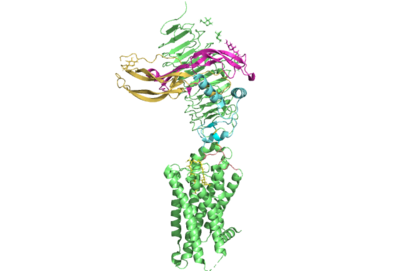This is a default text for your page '. Click above on edit this page' to modify. Be careful with the < and > signs.
You may include any references to papers as in: the use of JSmol in Proteopedia [1] or to the article describing Jmol [2] to the rescue.
Introduction

Figure 1. TSHR with TSH bound
Thyroid hormones exercise essential functions related to thymocyte activity as well as metabolic processes and oxygen consumption. Misregulation of thyroid hormones is the cause of many disorders related to hypo- or hyperthyroidism. Thus, understanding the signaling of synthesis and release of these hormones is essential to the development therapeutic drugs to combat disorders [3]. The initiation of the synthesis and release of these hormones is caused by the glycoprotein, thyroid stimulating hormone, commonly referred to as TSH or thyrotropin. The thyrotropin receptor (TSHR) is a G-protein coupled receptor that binds TSH and transduces signal through the cellular membrane in order to initiate synthesis and release of thyroid hormones (Figure 1)[4].
Structure
Several parts of TSHR are very important for the functioning of TSH signaling. The has been found to have impact on thyrotropin and autoantibody binding.
Relevance
Structural highlights
This is a sample scene created with SAT to by Group, and another to make of the protein. You can make your own scenes on SAT starting from scratch or loading and editing one of these sample scenes.

